May 1961 Popular Electronics
 Table of Contents Table of Contents
Wax nostalgic about and learn from the history of early electronics. See articles
from
Popular Electronics,
published October 1954 - April 1985. All copyrights are hereby acknowledged.
|
Prior to around 1960, the
nature of electromagnetic radiation outside the Earth's atmosphere was entirely
a matter of scientific conjecture. As is evidenced by this 1961 Popular Electronics
magazine article, at the time it was still not known for certain whether electromagnetic
energy outside the bands transmitted through the ionosphere existed for sure. There
was of course no reason to believe that low frequency, long wavelength radio waves
were not present along with the rest of the spectrum, but experiments needed to
be developed that would launch satellites above the atmosphere to detect probable
out-of-band signals and then re-transmit them on frequencies known to easily penetrate
the "ether." Many failures occurred along the way, but persistence paid off in what
is today a very well explored and documented outer space. Prior to the last half
decade, groups like NASA were more interested in conducting research than wasting
precious allocated funds on unrelated projects like the utterly unrelated studies
regarding the
end of western civilization and
outreaches to certain religious groups.
Space Electronics: Satellites and ET EM Waves
 A monthly report on satellite electronics and
communication in interstellar space. A monthly report on satellite electronics and
communication in interstellar space.
By Oliver P. Ferrell
Editor
The atmosphere we breathe has a dual purpose-it supplies life-sustaining oxygen
and serves as an "invisible shield" to protect earthlings from the harmful radiation
abounding in outer space. This shield does have one tremendous disadvantage: radiation
that cannot pierce the shield from without is therefore probably unknown to us -
and part of this radiation is in the radio-frequency band below 500 kc. Scientists
have long wondered if by any chance there are radio signals outside the earth's
atmosphere in the very-long-wave band. The only way to find out is to go outside
the atmosphere and listen.
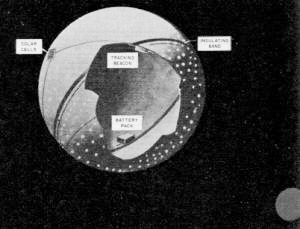
Apparently damaged during the unfolding of Explorer IX, the beacon
transmitter did not operate. It was powered by solar cells.

Explorer IX was carefully packed into nose of Scout II rocket
and launched by NASA. Test was only partially successful.
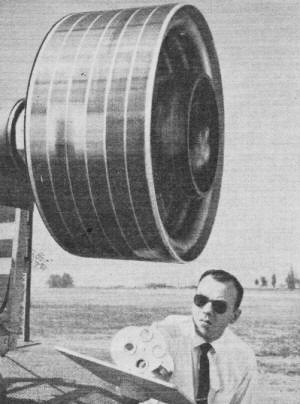
Spinning satellite, built by Hughes Aircraft, is an "active"
repeater. It weighs 32 pounds and is powered by silicon cells.
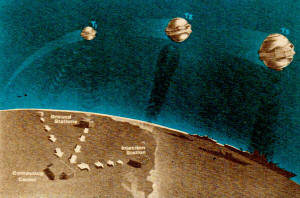
The Transit satellites are navigational beacons operating on
paired frequencies. Transit III-B is on 54, 162, 216, and 324 mc.
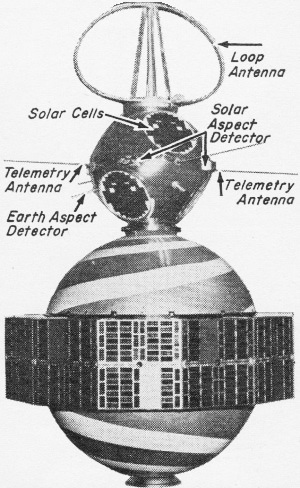
The "neck" joining Transit III-B and the NRL LOFTI satellite
failed to separate after February 21 launch.
What's Out There Department. Just such a project is being discussed
as a joint British/NASA venture for 1961-62. Signals picked up by special British
receiving equipment tuned to the low frequencies would be rebroadcast on the v.h.f.
channels. A trailing long wire ejected by the satellite would make a resonant antenna
system.
Scientists reason that long-wave reception should be pretty good 1000 miles above
the surface. Lightning static which prohibits low-frequency reception of weak signals
will probably be largely screened off by the ionospheric "shield."
A "reverse" of this experiment was conducted during the lifetime of satellite
Explorer VI (launched August 7, 1959). Aboard the payload was a U. S. Navy receiver
tuned to NSS on 15.5 kc. Apparently the idea was to determine the strength of this
low-frequency signal - the results have never been made known. Some Navy technicians
say that satellites may provide the answer to communicating with underwater submarines,
but just how remains a mystery in our eyes - packing "Big Jim," the Navy's present
megawatt long-wave transmitter, into a satellite doesn't seem quite possible.
A second attempt to monitor powerful signals on the low frequencies was made
with the LOFTI satellite - launched February 21, 1961. LOFTI contained a U. S. Navy
receiver tuned to the 300,000-watt signal of NBA. This station is on 18 kc. from
the Canal Zone. This satellite rode "piggy-back" on Transit III-B (see photo above).
One of the two low-frequency receivers aboard LOFTI is working and the characteristics
of 18-kc. reception are being recorded.
Satellite Briefings. Although the Russians have widely publicized
the "fact" that their Venus probe satellite operates on 922.8 mc., it has not been
heard by monitors in North America. The British receiving station at Jodrell Bank
was given sufficient information to track this satellite in late February. However,
the Russian Venus probe did not respond to "ground command" signals after February
22nd (it was launched February 12th). Keyed to respond every five days, the Venus
probe could not be heard on Monday, February 27th, nor Saturday, March 4th.
The Venus probe is supposed to have carried four antennas - one non-directional,
two moderately wide beams, and one very sharp beam antenna. The latter beam had
been designed to unfold to a six-foot diameter when the probe reached the vicinity
of Venus.
A 12-foot polka-dot balloon was launched by NASA from Wallops Island on February
16. Called Explorer IX, the beacon transmitter - operating on 136 mc. - was damaged
as the balloon unfolded from the rocket's fourth stage. Several days later the satellite
was "found" through optical means and is now in orbit. Explorer IX is too small
for Echo-type communications and was launched to measure air drag on balloon satellites
in the upper atmosphere.
Three new satellites can be added to the list of "Radio Signals from the Satellites"
appearing on page 65 of our April column. They are Discoverer XXI, gathering infrared
data, Transit III-B, and LOFTL. Frequencies used by Discoverer XXI have not been
revealed. Transit III-B is putting out weak signals on exactly 54, 162, 216 and
324 mc. (the same as Transit II-A), plus a special transmitting setup on 224, 421
and 448 mc. LOFTI is on 136.0 mc.
As we mentioned last month, Echo-type satellites are also called "passive" satellites
- meaning that they simply reflect radio signals. Active satellites contain radio
receivers and transmitters to rebroadcast signals upon command from ground stations.
The Courier I-B is a good example of a working "active" satellite.
Vastly improved passive satellites have been suggested by the Ryan Aeronautical
people. Some of their proposed designs are shown at the bottom. Included are the
corner reflector, wide-band multi-helix, and resonant dipoles with dual polarization.
Each design has been calculated to be more efficient than the spherical balloon.
Engineers and space experimenters hope that the resonant dipole idea will be exploited
in a satellite launching later in 1961.
Because of interference problems near the 108 mc. frequency used by the American
satellites, all launchings after June 1961 will be tracked with beacons operating
between 136 and 137 mc. Minitrack stations (to be discussed in a later column) are
being converted to receive 136-mc. signals.
Space Studies. Two frequencies have been allocated to the ITT
Laboratories, Nutley, N.J., for study of space communications theory. The authorization
is for 2120 and 2299.5 mc., although the latter channel will be the only one available
after July 1.
According to reports, ITT will bounce signals from passive satellites (and possibly
the moon) in order to study interference to conventional earthbound systems. All
transmissions will be from Nutley, N. J., with a power of about 10 kw.
At Minus-One. Two California scientists have recommended that
a special radio transmitter be included in our Mars and Venus probes. This transmitter
would not be operated by any personnel sent on such expeditions, but would be a
"last gasp" transmitter - should the probe be destroyed by intelligent beings!
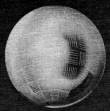 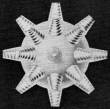 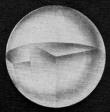
Suggested designs for passive or Echo-type satellites worked
up by Ryan Aeronautical Company. At the top is a corner reflector fitted into a
sphere. In the center, 26 cones have been formed into helical antennas. At bottom,
dipole strips have been attached to the balloon - they are at right angles to one
another to counteract polarization changes as the satellite spins and wobbles in
orbit.
Posted January 3, 2022
(updated from original post on 4/17/2014)
|









 A monthly report on satellite electronics and
communication in interstellar space.
A monthly report on satellite electronics and
communication in interstellar space.







